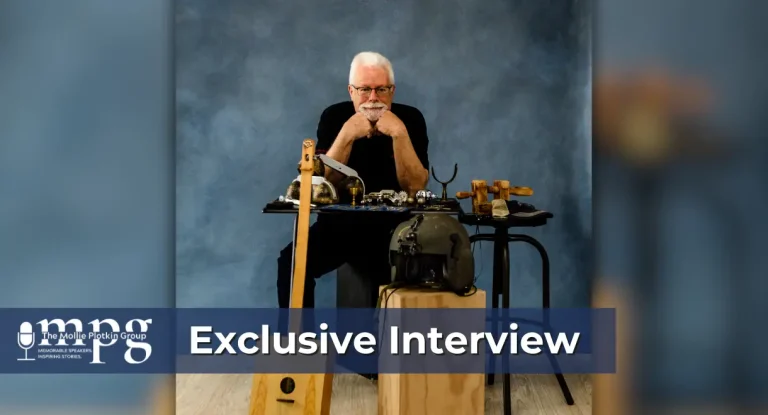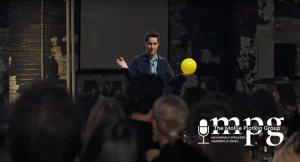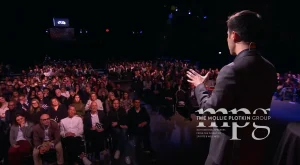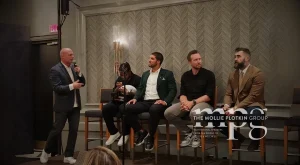Sound is 50 percent of the moviegoing experience.
George Lucas, Director of Star Wars
Below is our interview with John Roesch, the foley artist behind Star Wars, Marvel, Disney, and countless other cultural touchstones of American media. Having retired as the Head Foley Artist of Skywalker Sound in early 2024, Roesch now performs live Foley demonstrations to inspire and educate audiences that may know very little about what a Foley artist is, and their importance in film and television.
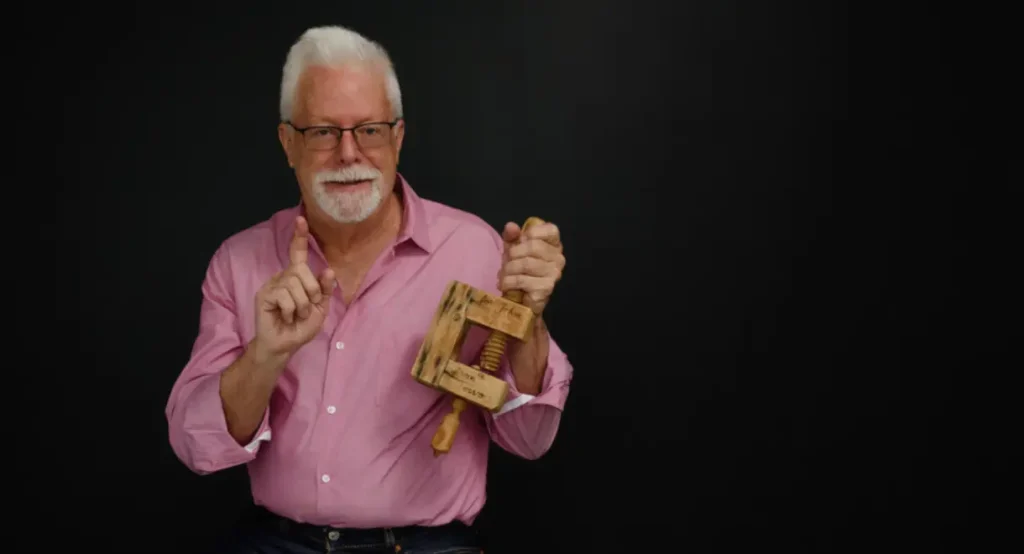
What is a Foley Artist?
A foley artist produces incidental sound effects for film and television. Examples of incidental sound effects include footsteps, a kiss, or breaking glass.
Foley artists are employed in the production of all major motion pictures and television series. Additionally, video games and narrative podcasts occasionally use Foley to provide a cinematic experience.
Foley art replaces production sound, or the audio that was recorded at the same time as the film. Why? Because the sounds captured on-set are often muffled or inaudible.
What’s more, the post-production Foley can be used to convey greater meaning than the original sound. For instance, a Foley artist will make a villain’s footsteps loud and imposing, while a love interest’s footsteps will be light and elegant.
Whether it’s Batman’s cape flowing in the wind, or the slam of a courtroom gavel, Foley artists make the scene come to life by drawing focus towards key aspects of the visuals.
Why are they Called Foley Artists? Because of Jack Foley
Why exactly is it called Foley? Well, this is because the art form was named after its creator, Jack Foley.
Having just come back from the First World War, Jack Foley noticed that sound was starting to become commonplace in films. Foley began contacting people he knew in the industry, and it wasn’t long before he became involved with this new aspect of post-production in film.
As time went on, Jack Foley became synonymous with sound effects in film. He would eventually go on to work on The Phantom of the Opera and the original Dracula movie.
It was around this time when Foley’s career really took off, leading to the name “Foley Effects”.
Really, it was the transition from the silent film era that allowed foley art to take off. This era spawned a whole new industry, and decades later, a young John Roesch would eventually stumble into a life-long career.
John Roesch: The Man Behind the Sounds
You’ve all likely seen (or should I say heard) at least some of John’s work. John has a more than impressive resume, including foley credits for classics such as, E.T., The Empire Strikes Back, Back to the Future, and many more.
After learning more about John, I was a bit floored when I was able to secure an interview with him. However, I was glad I did because I learned more about Foley and the different projects John has worked on.
With such success in this niche field, I had to ask John how he got started in the industry. John said, “ultimately it really comes down to having a lot of luck, but also meeting the right people.”
John tells me that he never really intended to become a foley artist. Yet, in 1972 he was helping a friend make a film, and they asked John to assist in creating Foley effects.
John agreed to this, and as he was making the sound effects, thought to himself “wow, this is really stupid.” Not knowing that this would inevitably be his career, John was initially uninterested in Foley and wanted to be a director.
However, he got a call that night to help the following day with more Foley effects. His apartment manager got him a job at a small independent studio. It was here where John learned things that he would carry with him throughout the rest of his career.
According to John, “I walked in, interviewed, started working that day and never stopped 45 years later.”
The Number One Rule of Foley? Go With What Feels Right
Interestingly, John told me that many Foley effects are not exact re-creations of real sounds.
“It’s somewhat counterintuitive if you were to Foley every footstep you hear. Most likely, the end result is not going to feel convincing to the viewer.”
John says this is because certain sounds don’t “feel right” from the viewers perspective. We might not realize it, but we expect things to sound a certain way in TV and film.
One example John brings up is that the sound of horses’ hooves in Western movies are not exactly accurate.
“In Western movies, you would normally hear a horse running and it would have a three-beat pattern. This is not actually what a horse would sound like.”
John says that this goes back to the old radio days, especially on shows like The Lone Ranger. Back then, you would not only have actors and actresses in the studio, but also sound effects people.
The Foley artists back then would use coconuts, and they would pioneer this “three-beat” pattern to impart the sound of a horse galloping. Foley artists still use this pattern today. Its widespread historic use conditioned us to expect it.
Favorite Effects to Make
John says his favorite effects are the classic “Western” sound effects. Sounds like spurs jingling, cowboy boots on wood, horse hooves and gunshots.
Roesch says that these sound effects are some of the most raw and original sounding. Many of the effects used in these Western films have become staples of the Foley artist sound library, and for good reason.
Besides this, John says that one of his favorite effects to do is properly re-creating the sound of footsteps. Roesch says this is, surprisingly, one of the hardest sounds to actually recreate.
“Getting the proper sound of a footstep that sounds correct is one of the hardest things to do in Foley. Actually creating footsteps that have feeling and soul is very difficult”
Most Challenging Film to Work On
One thing that I was curious about, was the more challenging projects that John has worked on. More specifically, I wanted to know if there were any sound effects that were particularly difficult to make.
John responded to this by saying, “yes, there are many times where you’re just not quite sure what’s going to work.”
“In Back to the Future you’ve got Doc Brown reloading the plutonium into the DeLorean, what does that sound like?” John goes on to say, “my method to get around this is I try to hear things in my mind as I see them. Then I will figure out how to create that.”
Roesch explains how he eventually came up with this classic sound from Back to the Future. To make this sound, he re-created the sound of a glass tube sliding, as well as a sucking sound.
He did this by actually using a plunger to create a sucking sort of effect. John added that, “this just goes to show you that what you see isn’t always what you’re going to use for the sound. But our ears believe it, and hopefully yours will too.”
Another challenge for John was doing sound for the James Cameron movie, The Abyss. It was especially challenging, because so much of the film took place underwater.
Since everything was underwater, this made things sonically more challenging as well, since water just muffles everything. To compensate for this, Roesch and his team really had to think outside of the box to capture certain sounds.
For example, in the film there’s certain shots where a submarine is passing by underwater. To emulate this sound, they attached a microphone to a garden hose, took it underwater, and turned the hose on.
The end result was a convincing sound of a large object moving underwater. But, it was because of scenarios like this that the film was so difficult to do Foley for.
In fact John says himself, “it was probably one of the hardest films I’ve had to do work on, or at least in the top five.”
Most Proud Accomplishments
When asked what his proudest accomplishment was, he said it was the work he’s done on the movie Schindler’s List.
John says that he is most proud of this, because it is a true account of the events of the Holocaust, and because “we are doomed to repeat history if we don’t understand it.”
Second to this, John says that he is immensely proud of all of the Disney feature films he has contributed to, including the Lion King. John elaborates, and says that doing Foley for animated films is much more difficult, since you’re in charge of bringing these characters to life.
Also, as you could imagine, the sounds that come from cartoons and animated films are much more open to interpretation.
One other thing John tries to do is to be a sounding board for younger people who want to get into the industry.
He even hosts a meeting once a week where other Foley artists give advice and tips on how to navigate the industry, as well as a FB page that boasts over six thousand members.
Resources like this are incredibly helpful for younger people who are trying to learn more about Foley or other aspects of sound design.
The Importance of Sound Effects in Film and TV
Overall, I’ve come to realize that Foley artists are an incredibly overlooked aspect of the film and TV industry. Movies just wouldn’t be the same without sound designers and Foley artists.
They’re the ones that have to make the artistic decisions that make a film much more enjoyable. Every effect needs to sound right from the viewer’s perspective, and there is a painstaking amount of time that goes into getting it just right.
Just think about all the movies you’ve seen, and how nuanced the sound effects are. Without this aspect of post-production, the movies that we know and love would be incredibly bland.
Like any art form, it is the details that make a truly astonishing piece of work stand out. After talking to John, I realize that Foley artists are no exception to this statement.
John Roesch is also available as a keynote speaker, and if you’d like to hire him please contact the Mollie Plotkin Group!
